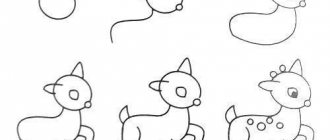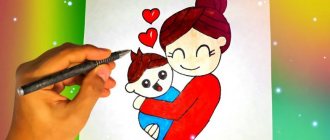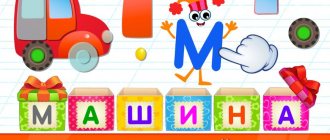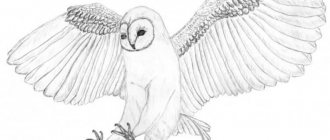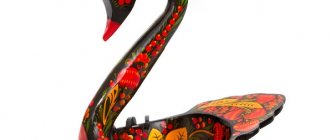Types of folk crafts and paintings
Russian regions are rich and diverse both in their landscapes and in their customs and traditions. Many places even have their own dialect. All this shaped the culture and artistic creativity of every corner of our country. For a long time, different traditions of folk crafts have developed. The most famous include the following:
- Dymkovo, Filimonovskaya, Bogorodskaya toy;
- Gzhel ceramics;
- Vologda and Vyatka lace;
- Tula samovars;
- Rostov enamel;
- Mstera, Fedoskino, Palekh miniatures;
- Zhostovo trays;
- Gorodets, Khokhloma painting.
Each of them is very original and unique, but they all reflect the culture and spirituality of the Russian people.
What objects are decorated with Khokhloma painting
Traditionally, any household items made of wood were made in this style:
- spoons;
- nesting dolls;
- trays;
- dishes;
- caskets;
- chests;
- barrels;
- boxes;
- spinning wheels;
- handles and handles;
- vases;
- cutting and decorative boards.
In its modern version, when interest in Russian folk motifs is quite high, Khokhloma painting sometimes appears on very exotic surfaces:
- fabric (for bed linen, for example);
- nails;
- keychains;
- lighters;
- screen and panels of a smartphone or laptop;
- body (tattoo and body art);
- cars (airbrushing);
- bags (paper and plastic).
Thus, almost any object can now be decorated with Khokhloma painting.
Painted Khokhloma box: master class
The very name of this product indicates its nobility and grace. The box turns out to be fabulous, traditionally colorful, but very unusual.
What you will need:
- paints;
- background paint (bronze or copper);
- masking tape;
- squirrel brushes;
- varnish;
- varnish brush;
- pencil;
- tracing paper;
- sandpaper;
- wooden box.
The box turns out fabulous, traditionally colorful, but very unusual
Progress:
- Plaster all uneven areas on the box. Only after the surface becomes smooth can you begin to work.
- Cover the surface of the product with background paint and wait until it dries.
- Draw a drawing on paper that will later be applied to the box.
- After the box has dried, transfer the prepared sketch onto it with a pencil. To do this, attach the paper to the box itself using tape.
- Outline the design with black paint using the thinnest brush.
- Paint larger elements black as well.
- Wait until the black paint dries.
- After this, paint all the other elements and give the paint more time to dry.
- Additionally decorate the product with tendrils and droplets.
Apply varnish to the box (at least two layers) and let it dry.
Samples on paper
If you are new to this business and are just starting to master the basics of drawing Khokhloma painting, it is better to practice on ordinary Whatman paper. As exercises for positioning your hand, choose simple elements: berries, leaves.
All of them are based on certain movements of the brush. Even if you later work on the finished pencil outline, the circles and curls should be even. It is better to do them in one go.
If you want to know how to learn how to draw a crested child, it is best to master this technique with him, also on paper. The same type of exercise in the form of leaves and berries quickly gets boring for children, so suggest depicting a round tray, plate, spoon or vase. Make the shape of the object yourself, and give your child the opportunity to decorate the object.
Master class on making tableware (papier-mâché) and painting it in the “Golden Khokhloma” style
Elena Mitenkina
Master class on making tableware (papier-mâché) and painting it in the “Golden Khokhloma” style
.Set of dishes (Papier-mâché). Painting "Golden Khokhloma"
(Copyright. Elena Nikolaevna Mitenkina)
Golden Khokhloma is one of the most beautiful types of painting in Russian art.
This is a painting of wooden utensils and furniture, done in red, green and black on a gold background. Presumably Khokhloma painting originated in the 17th century on the left bank of the Volga.
Russian culture is rich and beautiful. Each painting is unique and multifaceted, be it the magical Gzhel, Gorodets, Kargopol or Golden Khokhloma. I love every type of painting, but today I want to focus on Khokhloma. I like to create something new with my own hands and then paint it. Under the brush, the object seems to come to life, becoming original and unique.
I present to your attention a Master class on making papier-mâché tableware and painting it in the “Golden Khokhloma” style.
For work we need:
• vase, jug, any container that resembles a vase (whatever is at hand);
• paper, newspapers, white sheets;
• PVA glue;
• sunflower oil;
• white gouache for priming.
• gouache (red, black, yellow) for painting;
• “golden” paint (if available, work with it looks more complete and solemn;
• varnish (colorless);
• brushes;
• a simple pencil.
1. Finely tear the paper (newspapers), soak it in water until it swells and squeeze it out.
Apply sunflower oil to a vase or jug (whatever is at hand) on the outside and cover the vase with paper. First 1-2 layers. Let dry. Again 3-4 layers, let dry... and so on. There should be approximately 12-13 such layers. For the density and reliability of the product, I coated it with glue every 2-3 layers. The entire “structure” took a week to dry. After making sure that the layers were dry and the product was ready, I cut the vase with a stationery knife from top to bottom and removed the paper frame. The cut area was joined and glued with white paper. To make the vase blank uniform, cover it white. I also made a plate (the manufacturing technology is the same). After painting it white, this is what came out.
2. The product is ready for painting. First, I drew the intended drawing with a simple pencil. I used elements of the Golden Khokhloma painting (curl, flower, leaves, berries).
3. At first I painted all the details in yellow.
4. Then I drew all the elements in red.
5. After drawing all the elements in yellow
and
red
, included
black
.
When I applied the main ornament, I used gold-colored paint to complete the work (along the edge of the product, in the elements of leaves and curls).
After completing all the painting, making sure that nothing needed to be corrected, I coated the entire work with varnish.
This type of painting is very close to me, it is simple and at the same time beautiful. A little later, using the same technology, I made a bowl. Here's what I got.
.
Purchasing materials
Choose the right base. The shape can be round, rectangular, square, or complex carved. It is better if the board has a hole to hang it on a nail or hook. Avoid using plywood or untreated wood. The surface for applying the pattern must be smooth, without depressions, notches and burrs. The easiest way is to buy a high-quality base at a craft store. If this is not possible, but there is a board ready to size, properly treat the surface with sandpaper. If this is not done, all the unevenness will remain after applying the paint. They can interfere with the perception of the drawing and will interfere with drawing.
Elements of Khokhloma for preschool children: step-by-step templates
Even a small child can create a Khokhlo pattern with his own hands, having mastered basic skills . Children's drawings have always been valued and pleased the eyes of parents. Often, an activity such as applique is carried out in the senior or preparatory group of a kindergarten. To create a pattern, it is enough to make a stamp from a tube and paper into which the paint will be dipped. Smaller elements are already painted with a brush, as in the pictures.
Even a small child can create a Khokhlo pattern with his own hands, having mastered basic skills
Drawing with children:
- lingonberry. Using a stamp, red circles are drawn, which do not need to be supplemented with other elements;
- currant. Berry circles are collected near a blade of grass, on which golden dots must be placed with a brush;
- Rowan. Berries are drawn with a stamp, and fairly narrow and elongated droplets are added with a brush, as well as leaves at the base of the resulting bunch. Additionally, you need to make inclusions of gold color;
- raspberries. Six circles are drawn with a stamp, without maintaining a certain distance, but slightly overlapping one on one. Highlights are added using the grass blade technique. Additionally, dots are placed with a brush;
- sepal. Blades of grass are gathered together, a twig and leaves are drawn.
Pattern selection
Choose a suitable ornament motif. It doesn’t matter whether your Khokhloma painting will be simple or complex. Step-by-step drawing of each element will help you depict any object from a combination of twigs, leaves and berries to an exclusive bird of paradise. You just need to do everything piece by piece from simple to complex. Given the availability of computer technology, anyone can find the necessary image on the Internet, print it, for example, on film, and transfer the contours to a wooden base. It is more difficult to draw lines on a round surface. However, in this case, you can simplify your task by making several stencils of repeating elements.
Which color to choose?
You will need paints that are suitable for wood surfaces. The simplest and cheapest option is gouache. However, it does not form a waterproof surface once dry. It is necessary to add PVA glue to it, about a quarter of the volume of pigment, but not every color will respond well to this combination. It’s better not to take risks, but simply coat the finished product with transparent wood varnish. This will protect the drawing from moisture and other adverse factors. Another option is to use acrylic paints. They are waterproof and suitable for wood. Moreover, after such a layer has dried, you can even apply gouache on top. This means that the black background can be done with acrylic, and the pattern itself can be done with gouache.
Buy several brushes with fine tips. Squirrel, kolinsky and synthetic numbers from the first and above are suitable. The quantity and size depend on your design. You will need a thin brush in any case, and you can determine the maximum size visually depending on the planned design.
We perform the technique of horse writing with our own hands
This technique is quite simple and consists of applying patterns of red, yellow or black colors to the processed workpiece. As a rule, this technique is used to draw a gingerbread pattern, when smaller elements of the ornament are applied around a large central pattern.
To obtain drawings using this technique, large colored patterns are initially applied, then a black background is applied to the free space and, after the paint dries, the “Grass” pattern is applied on top. The finished product is coated several times with a special fixative varnish, drying each layer, and sent to an oven heated to 150 degrees for 4 - 5 hours until a golden-bronze film is formed.
Despite the fact that the motives of the Khokhloma paintings are quite clearly defined, real masters approach this process creatively and constantly come up with new intricate images of fabulous animals, birds and plants. Beginners, due to lack of experience, are allowed to use a stencil to apply a pattern or simple patterns for training.
But before you start training in Khokhloma painting, you need to prepare all the necessary materials and tools. And here a corresponding question arises: what do the masters of this art use to draw such intricate curves and curls? Basically, Khokhloma craftsmen use brushes made from squirrel tails - with its help you can draw both thin and thick lines, just by changing the pressure.
It is impossible to make full-fledged kitchen utensils from which food could be eaten at home, but making a souvenir to decorate the kitchen is quite accessible to anyone.



